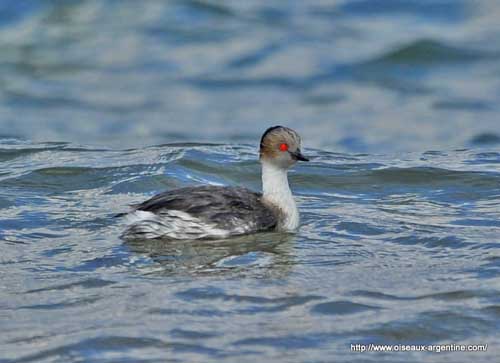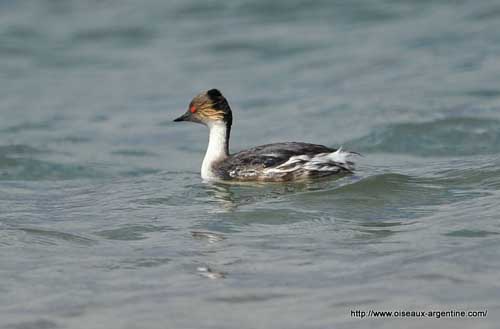
Fr: Grèbe aux belles joues
All : Inkataucher
Esp : Zampullín Blanquillo
Ital : Svasso argentato
Nd: Zilverfuut
Sd: Silverdopping
Port: Mergulhão-de-orelha-amarela
Photographers:
Philippe and Aline Wolfer
OISEAUX D'ARGENTINE
Text by Nicole Bouglouan
Sources:
HANDBOOK OF THE BIRDS OF THE WORLD vol 1 by Josep del Hoyo-Andrew Elliot-Jordi Sargatal - Lynx Edicions - ISBN: 8487334105
A GUIDE TO THE BIRDS OF COLOMBIA by Steven L. Hilty and William L. Brown - Princeton University Press – ISBN 069108372X
BirdLife International (BirdLife International)
Arthur Grosset's Birds (Arthur Grosset)
Silvery Grebe
Podiceps occipitalis
Podicipediforme Order – Podicipedidae Family
BIOMETRICS:
Length: 23-28 cm
Weight: 340-400 gr
DESCRIPTION:
The Silvery Grebe is a South American species which frequents freshwater lakes, even at high elevation in the Andes.
The adult has dark grey upperparts with blackish wings.
The underparts are white.
On the head, crown and head sides are grey. We can see silvery-buff feathers forming facial tufts on each side, and a flattish black crest. The hindneck is black, whereas the foreneck is white.
The pointed bill is black. The eyes are bright red. Legs and feet are black.
Both adults are similar. In non-breeding plumage, they are duller and lack the facial tufts.
The juvenile resembles non-breeding adults, but it has grey nape.
We can find two subspecies:
P.o. occipitalis is here described and displayed. It is found in C and S Chile, C and S Argentina and Falkland Islands. It winters in the northern parts of the range.
P.o. juninensis has mostly grey facial tufts. It occurs in C Andes of Colombia to N Chile and NW Argentina.

VOICE: SOUNDS BY XENO-CANTO
The Silvery Grebe is usually silent outside the breeding season. Its vocal repertoire includes some variations according to the season.
Grebes usually give a variety of barking, trilling, whistling or wailing calls. These sounds are used in displays, alarm or aggressive encounters.
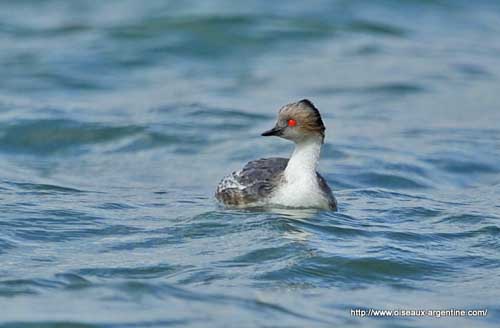
HABITAT:
The Silvery Grebe frequents open freshwater or slightly alkaline lakes during the breeding season. This species needs large shallow water areas and thick reedbeds along the shores.
But at high elevation, it can be found on lakes with bare shores. In this case, it nests on floating and submerged vegetation and in open. This species can be seen in lowland below 1300 metres, but also in puna, up to 3000-5000 metres of elevation.
The Falklands birds frequent the coastal kelp in autumn and winter.
RANGE:
See above in “subspecies”.
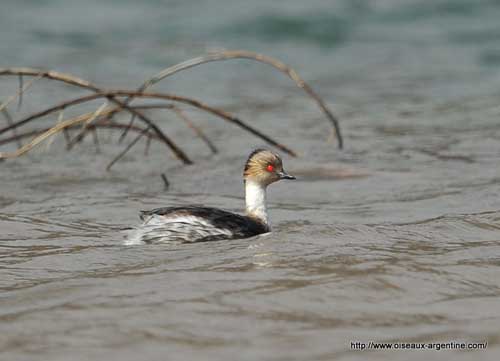
BEHAVIOUR:
The Silvery Grebe feeds primarily on small arthropods, insects and their larvae, and small crustaceans. But fish and plant matter are also consumed.
It pecks food items from the surface, but it also may dives for a few seconds (15/20 seconds) to reach some underwater foliage or prey.
They can be seen singly or in small groups outside the breeding season during which they breed in colonies.
The Silvery Grebe is migratory on the southern parts of the range, and moves usually by night to reach the northern regions. They usually fly by night and swim along the coasts by day.
The Falklands birds are resident, only performing some local movements.
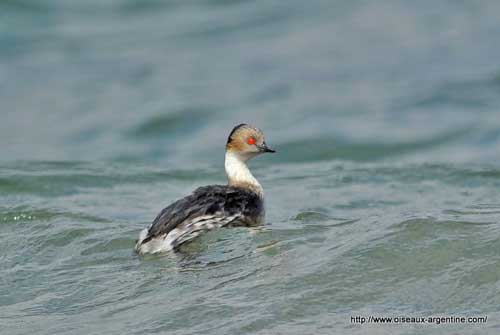
FLIGHT:
As other grebes’ species, the Silvery Grebe usually avoids flying and prefers to patter over water or to dive is alarmed.
REPRODUCTION:
The breeding season varies according to the range.
The Silvery Grebe is a colonial breeder and may form large colonies of 400/1000 pairs in some regions. The nests are small and they touch each other. Several nests can be built on the same floating vegetal platform. The nest itself is a floating structure made with weeds and other plant materials.
The female lays 1-4 pale blue eggs, and generally, there is only one brood. The incubation lasts 18 days. As in other grebes’ species, the chicks are covered with striped grey down above and paler below. They are often carried on parents’ back.

DIET:
The Silvery Grebe feeds mainly on insects and their larvae (caddifish, corixid, bugs and beetles), and small crustaceans such as freshwater shrimps. They also feed on fish and plant matter.
PROTECTION / THREATS / STATUS:
The Silvery Grebe is usually uncommon, but according to the range, this species can be locally common in Falklands and even abundant in Argentina, Chile, Bolivia and Peru.
It is rarer in N of the range, and probably declining.
However, the species is not currently threatened.
